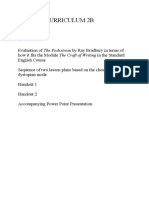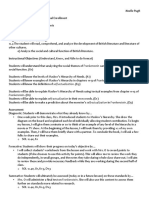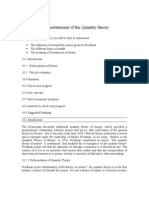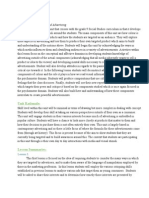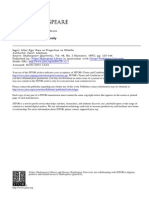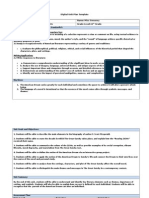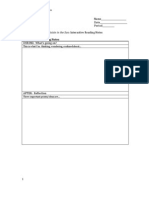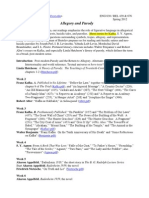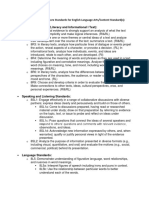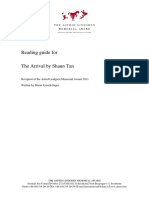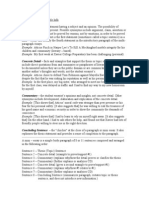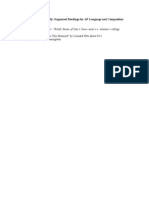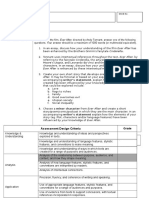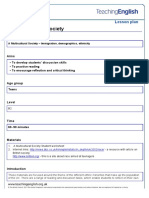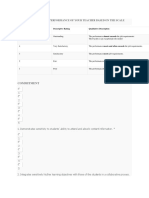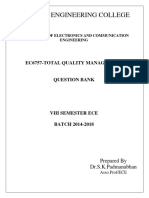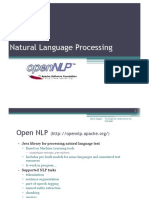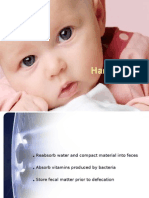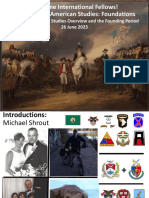Professional Documents
Culture Documents
Media Literacy Unit Plan
Media Literacy Unit Plan
Uploaded by
api-309886947Original Description:
Original Title
Copyright
Available Formats
Share this document
Did you find this document useful?
Is this content inappropriate?
Report this DocumentCopyright:
Available Formats
Media Literacy Unit Plan
Media Literacy Unit Plan
Uploaded by
api-309886947Copyright:
Available Formats
WEEK ONE TEACHING BLOCK
ORILLIA
CAMPUS
BACKWARD DESIGN/DOWNWARD DESIGN CROSS CURICULAR PLANNING MODEL
Subjects /Strands: Language Arts/Media Literacy
Dates of possible implementation: March 21 to March 25
A. BIG IDEA
FOR THIS
UNIT
CULMINATING
TASK
Rich
Performance
Assessment
Task pg. 69
Drake Text
Grade: 6
Culminating task due date: March 25
1. All media messages are constructed.
2. Different people experience the same media message differently.
3. Most media messages are organized to gain profit.
Students will work individually to create a movie poster based on a book that they have read
(The book that they choose for their book report) to demonstrate their understanding of the
different media literacy concepts taught in this unit (identify the parts within the media form,
the reasoning for those parts, who is your audience, and what message is your media form
trying to convey). Students will also complete a short write up explaining their design choice.
Assessment For learning: I will evaluate students progress during minds on activities
(engaging prior knowledge) and during consolidation.
Assessment As learning: Students will be provided a checkbric that they can use as they
complete their poster.
Assessment Of learning: The poster and write up will be used to measure the students level
of understanding. Results will be recorded on a rubric.
Knowledge and Understanding: All Media messages are constructs, Audience Negotiate
Meaning, Media conveys a message and purpose.
Application of Knowledge and Skills: Can they apply that knowledge to create the movie poster.
WEEK ONE TEACHING BLOCK
ORILLIA
CAMPUS
B OVERALL
EXPECTATION(
S)
1. demonstrate an understanding of a variety of media texts;
2. identify some media forms and explain how the conventions and techniques associated
with them are used to create meaning;
3. create a variety of media texts for different purposes and audiences, using appropriate
forms, conventions, and techniques;
Form
SPECIFIC
EXPECATIONS 2.1 describe in detail the main elements of some media forms (e.g., drama scripts: cast of
characters, description of setting, acts, scenes, stage directions; television quiz shows:
(S)
host/hostess, contestants, prizes; magazines: cover images and text, table of contents, regular
columns, feature articles, advertisements)
Audience Responses
1.4 explain why different audiences (e.g., boys, girls, adults, seniors, various cultural groups)
might have different responses to media texts (e.g., movies, songs, websites, video games,
items of clothing)
Making Inferences/Interpreting Messages
1.2 interpret media texts, using overt and implied messages as evidence for their
interpretations (e.g., explain why the advertisements used in a particular magazine are
appropriate for that magazine, identifying the messages that would appeal to the magazines
audience; explain how advertisements for healthy food and those for fast food differ)
Producing Media Texts
3.4 produce a variety of media texts for specific purposes and audiences, using
appropriate forms, conventions, and techniques (e.g, a movie poster to advertise a movie
based on a narrative they have studied)
LEARNING
Day One: All media messages are constructed
Day Two: Audiences negotiate meaning
WEEK ONE TEACHING BLOCK
ORILLIA
CAMPUS
GOAL(S)
C SUCCESS
CRITERIA
ASSESSMENT
TASKS/STRATEGI
ES
ASSESSMENT
TOOLS
What recording
strategies will
teachers use?
POSSIBLE
ASSESSMENT
STRATEGIES
Day Three: Most media messages are organized to gain profit
I can: Use movie poster construct rules to create my own movie poster (Title, Main Characters,
Names of star actors, capture a small scene from the book,)
I can: make my movie poster to attract an audience of my choice.
I can: explain how my movie poster was constructed, who my intended audience is, the
message my poster is sending?
Assessment Of learning: The poster and write up will be used to measure the students
level of understanding. Results will be recorded on a rubric.
Knowledge and Understanding: All Media messages are constructs, Audience Negotiate
Meaning, Media conveys a message and purpose.
Application of Knowledge and Skills: Can they apply that knowledge to create the movie
poster.
Checklist
Rubric
Rating Scale
Anecdotal Comments
Feedback Form Self/Peer AaL/AfL
Other
For / A
Teacher Conference
Observation checklist
Exit Card
Interview
Self Assessment Checklist
Performance Checklist
Concept Attainment, Mind Map, Concept Map
Select Response
Peer Edit
Thumbs Up/Thumbs Down
Spot Check
Teacher Edit
Quiz
Checklist
Question and Answer
Discussion
Self Assessment Response Form
Demonstration
3-2-1
Other
WEEK ONE TEACHING BLOCK
ORILLIA
CAMPUS
D. LESSONS USING LAKEHEAD TEMPLATE & GUIDELINES
Briefly identify the topic, specific teaching/ learning activity, and specific expectation is for each lesson. Lessons
flow together and scaffold student learning. What teaching skills/concepts expectations are being introduced for
completion of culminating task? Outline or sketch out each lesson in the unit
LESSON
DAY ONE
Specific Expectation
Form 2.1 describe in detail the main
elements of some media forms (e.g.,
advertisements)
Learning Activity
Deconstruct different media forms.
DAY TWO
Specific Expectation
WHAT TEACHER
WILL DO
Minds On:
Engage prior
knowledge by
discussing
different forms of
media
WHAT STUDENT WILL DO
Action Two: Students will
work in groups of 4 to
deconstruct a media form
(poster, CD cover, Magazine
Cover, Book)
Action One: As a
class deconstruct
a movie poster
(parts and
purposes the
creator had for
those parts).
Minds On: Show
two commercials
for Moon Sand.
The product is
Action: Students Design a
pair of white shoes ( or what I
can find at the dollar store)
ASSESSMENT
(say write do)
Consolidation:
Have each group
share their media
form, discuss some
of the parts and
purposes for those
parts
Consolidation:
Gallery Walk
RESOURCES
*Movie
Poster
*Magazine
Cover
*Record or
CD Case
*Moon Sand
Video
*6 pair of
WEEK ONE TEACHING BLOCK
ORILLIA
CAMPUS
1.4 explain why different audiences
(e.g., boys, girls, adults, seniors, various
cultural groups) might have different
responses to media texts.
Learning Activity
In groups students will be given the
same item (pair of white shoes) and
design them to attract different
audiences.
DAY THREE
Specific Expectation
Making Inferences/Interpreting Messages
1.2 interpret media texts, using overt
and implied messages as evidence for
their interpretations
Learn Activity
Students will navigate through a website
and draw conclusions about what the
overall message is and what is the
purpose of the website.
essentially the
same but one is
being targeted to
boys and the
other commercial
is being targeted
to girls.
Each group will have to
design their product to
attract a different audience
( boys, girls, teenage girl,
teenage boy, mom, dad)
Discuss their
design choice and
what they learned.
Discuss the video
Minds On: Show
Levis commercial.
Discuss who they
think created the
commercial, what
is the purpose of
the commercial
and what is the
message?
shoes (or
what I can
find at the
dollar store,
they have to
be the
same).
*Crafts- to
design the
shoe.
Action: In groups of two
students will view the
following website
http://nutritionexploration
s.org/
Students will have questions
that will help guide them
through the website. The
questions will help them to
conclude:
*Who created the website?
*What do you think the
purpose was?
*What if any message did it
Consolidation:
*IPads
Discuss the website
and our findings.
*Chrome
Books
*Levis
Commercial
WEEK ONE TEACHING BLOCK
ORILLIA
CAMPUS
leave?
DAY FOUR:
Specific Expectation
Producing Media Texts
3.4 produce a variety of media texts for
specific purposes and audiences, using
appropriate forms, conventions, and
techniques (e.g, a movie poster to
advertise a movie
based on a narrative they have studied)
Minds On: Bring
a BigMac Burger
and compare it to
an ad for the Big
Mac. Have
students compare.
Why do you think
the ad looks
different than the
actual burger?
Show video
Learning Activity
https://www.youtu
be.com/watch?
v=oSd0keSj2W8
Begin Culminating Task (Movie Poster)
DAY FIVE
Minds On:
Action: Introduce
Culminating Task
You are a movie producer,
you came across a really
good book (the book chosen
for their book report) and you
want to create a movie based
on the book. Its your job to
make the book look good
(just like McDonalds brings
out the best features to make
the BigMac look good).
Students will create a Poster
to Promote the Film.
Review their
assignment
expectations.
Hand Out
Checkbric
*25 Pieces of
white paper
*25 pencils
*Crayons,
markers
*Macdonald
burger/Adver
tisement
*sample of
Poster
Along with the drawing
students will have to answer
the following questions.
(Identify the different parts?
Identify the different
purposes for each part? Who
is you audience? Who will
benefit from this movie?
What message are you trying
to portray?)
Action: Students will finish
Consolidation:
*trivia game
WEEK ONE TEACHING BLOCK
ORILLIA
CAMPUS
Success Criteria
Producing Media Text
3.4 produce a variety of media texts for
specific purposes and audiences, using
appropriate forms, conventions, and
techniques (e.g, a movie poster to
advertise a movie
Review everything
that we learned
(possibly in the
form of a game).
their poster.
Share some of the
Movie Posters using
appropriate
vocabulary.
Review
Expectations For
the Movie Poster
based on a narrative they have studied)
Learning Activity
Continue with Poster.
E. LEARNING
EXPERIENCES
AND
DIFFERENTIATIO
N
LEARNING
SKILLS AND
WORK HABITS
TO BE
ADDRESSED
Accommodation for distraction
Accommodation with LD
Two Modifications: Grade 3
*Need advice
Independent Work:
independently monitors, assesses, and revises plans to complete tasks and
meet goals;
uses class time appropriately to complete tasks;
follows instructions with minimal supervision
Collaboration:
accepts various roles and an equitable share of work in a group;
WEEK ONE TEACHING BLOCK
ORILLIA
CAMPUS
VARIETYOF
LEARNING
EXPERIENCES
responds positively to the ideas, opinions, values, and traditions of others;
builds healthy peer-to-peer relationships through personal and media-assisted
interactions;
works with others to resolve conflicts and build consensus to achieve
group goals;
shares information, resources, and expertise and promotes critical thinking
to solve problems and make decisions.
Ensure that there are a variety of learning experiences provided to match the class and
individual learning profile that you have developed for this group of learners (see next page
for listing)
WEEK ONE TEACHING BLOCK
ORILLIA
CAMPUS
Learning Experiences
Inquiry Questions
Anticipation Guide
Brainstorming
Case Study
Choice Boards
Class Discussion
Computer Simulation.
Concept Attainment
0Concept Formation
Concept Creation
Concept Mapping
Critical Dialogue
Cubing
Debate (Formal)
Debate (Informal)
Examine Both Sides
Four Corners
Game
Game Theory
Graffiti
Graphic Organizer
Graph Creation
Graphing
Guest Speaker
Inside/Outside Circle
Inquiry
Jigsaw
Journal Writing
KWL chart
Learning Centres
Learning Contracts
Metaphors
Movie Review/Analysis
Mind Map
Model Building
Note Making (student
generated)
Note Making (teacher
generated)
Numbered Heads
Jigsaw
Panel Discussion
Placemat
P/M/I
Problem Based Learning
Puzzle Pieces
RAFTS
Research (Guided)
Research (Independent)
Report Writing
Response Writing
Response Journals
Role Playing
Round Robin
Simulation
Snowball
Socratic Dialogue/ Rich
Questioning
Song Creation
Teams Games Tournaments
Three Way Debate
Think Pair Share
Think Pair Square
(Graduated)
Think Together Think
Apart
Thinking Routines
Tiering
Values Line
Venn Diagram
Video Clip
Word Wall
Word Web
Other
__________________________
WEEK ONE TEACHING BLOCK
CAMPUS
ORILLIA
You might also like
- Economics. Cambridge IGCSE. Susan GrantDocument12 pagesEconomics. Cambridge IGCSE. Susan GrantARYA JAIN 21111511100% (3)
- Albania The Bradt Travel Guide - NodrmDocument300 pagesAlbania The Bradt Travel Guide - NodrmKusaila100% (4)
- UL 583 UL 558: UL 583 Safety Rated TrucksDocument6 pagesUL 583 UL 558: UL 583 Safety Rated TrucksC.N. KrishnaNoch keine Bewertungen
- Digital Unit Plan Template - The Great GatsbyDocument5 pagesDigital Unit Plan Template - The Great Gatsbyapi-321967207Noch keine Bewertungen
- Catch22 Intro LessonDocument3 pagesCatch22 Intro LessonCaitlin HawkinsNoch keine Bewertungen
- English Curriculum 2b Assessment 1 19163042Document25 pagesEnglish Curriculum 2b Assessment 1 19163042api-368764995Noch keine Bewertungen
- The Greatest Muhammad Ali Book Common by Walter Dean by Author MyersDocument6 pagesThe Greatest Muhammad Ali Book Common by Walter Dean by Author Myerssarath chandNoch keine Bewertungen
- Crucible UnitDocument3 pagesCrucible UnitJerad DampsonNoch keine Bewertungen
- EulogyDocument2 pagesEulogylexy37Noch keine Bewertungen
- Close Analysis FireshadowDocument4 pagesClose Analysis Fireshadowapi-256384152Noch keine Bewertungen
- Titus Frankenstein MaslowDocument6 pagesTitus Frankenstein Maslowapi-317690044Noch keine Bewertungen
- Great Gatsby Lesson Plan Edsc 440sDocument8 pagesGreat Gatsby Lesson Plan Edsc 440sapi-449508169Noch keine Bewertungen
- Fences Sample PDFDocument15 pagesFences Sample PDFAhmed Shah T.Noch keine Bewertungen
- A Study Guide for Allen Ginsberg's "A Supermarket in California"From EverandA Study Guide for Allen Ginsberg's "A Supermarket in California"Noch keine Bewertungen
- 4 9 2018 Vanishing Honeybees - StudentDocument5 pages4 9 2018 Vanishing Honeybees - StudentJohn Mauricio Lasso DiazNoch keine Bewertungen
- Restatement of Quantity Theory of MoneyDocument6 pagesRestatement of Quantity Theory of MoneyAppan Kandala Vasudevachary67% (3)
- Unit Plan On Visual Literacy and AdvertisingDocument12 pagesUnit Plan On Visual Literacy and Advertisingapi-256459735Noch keine Bewertungen
- Iago - 'S Alter Ego Race As Projection in Othello PDFDocument21 pagesIago - 'S Alter Ego Race As Projection in Othello PDFHaji DocNoch keine Bewertungen
- English 11 Course Outline 2013Document3 pagesEnglish 11 Course Outline 2013api-54282398Noch keine Bewertungen
- The Great Gatsby Unit PlanDocument6 pagesThe Great Gatsby Unit Planapi-282064592Noch keine Bewertungen
- Nine Week Horror Unit HandoutDocument2 pagesNine Week Horror Unit HandoutStewart SternbergNoch keine Bewertungen
- Ap Language and CompositionDocument7 pagesAp Language and Compositionapi-263349648Noch keine Bewertungen
- Guided Reading Questions 2Document1 pageGuided Reading Questions 2api-491269653Noch keine Bewertungen
- Raisin in The Sun Act 1, Scene 1Document2 pagesRaisin in The Sun Act 1, Scene 1Lori Tolar100% (1)
- Allegory and ParodyDocument4 pagesAllegory and ParodyVERTURICANoch keine Bewertungen
- Sula Lesson PlansDocument20 pagesSula Lesson Planstatertot100% (3)
- Identifying Literary Devices in "A Retrieved Reformation," by O. Henry Lesson PlanDocument6 pagesIdentifying Literary Devices in "A Retrieved Reformation," by O. Henry Lesson PlanVictoria AnneNoch keine Bewertungen
- The Question of Genre in Paul AusterDocument9 pagesThe Question of Genre in Paul AusterJulieta MaffeiNoch keine Bewertungen
- Fox ItlessonoverviewDocument2 pagesFox Itlessonoverviewapi-333995924Noch keine Bewertungen
- Crucible Lesson PlanDocument3 pagesCrucible Lesson Planapi-383537126Noch keine Bewertungen
- Memoir RubricDocument2 pagesMemoir Rubricapi-242419996Noch keine Bewertungen
- Anticipation Guide Book ThiefDocument3 pagesAnticipation Guide Book ThiefNightwing10Noch keine Bewertungen
- Letter Defending Absolutely True Diary in Meridian School District, IdahoDocument2 pagesLetter Defending Absolutely True Diary in Meridian School District, IdahoncacensorshipNoch keine Bewertungen
- Reading Guide Tan ArrivalDocument5 pagesReading Guide Tan ArrivalBelalNoch keine Bewertungen
- Walden Unit Plan: Mrs. Baker: Online TextDocument6 pagesWalden Unit Plan: Mrs. Baker: Online TextjosecgarzaNoch keine Bewertungen
- Gatsby Choice MenuDocument3 pagesGatsby Choice Menuapi-502027563Noch keine Bewertungen
- Grade 6 Literacy Tone MoodDocument8 pagesGrade 6 Literacy Tone Moodapi-466313227Noch keine Bewertungen
- Elements of PoetryDocument15 pagesElements of PoetryAyo NelsonNoch keine Bewertungen
- Literature Circle LessonsDocument3 pagesLiterature Circle Lessonsapi-323099162Noch keine Bewertungen
- The Highway Man. Lesson - AnthologyDocument11 pagesThe Highway Man. Lesson - AnthologyJordan Hugh SamNoch keine Bewertungen
- Jane Shaffer Writing Style InfoDocument1 pageJane Shaffer Writing Style InfoEmaanHaqueNoch keine Bewertungen
- Second Assigment - Literary ModernismDocument14 pagesSecond Assigment - Literary ModernismGM Yas100% (1)
- Fig Lang QuizDocument2 pagesFig Lang QuizMelba O. CruzNoch keine Bewertungen
- AP Thematic ReadingsDocument15 pagesAP Thematic Readingshstring2Noch keine Bewertungen
- Course Concepts HandoutDocument4 pagesCourse Concepts Handoutapi-520766585Noch keine Bewertungen
- Unit Plan: Short Stories: For: Grade 7 and 8 Students in The English Classroom TitleDocument49 pagesUnit Plan: Short Stories: For: Grade 7 and 8 Students in The English Classroom Titleste100% (1)
- Unit Plan - Twelfth NightDocument7 pagesUnit Plan - Twelfth Nightapi-200163711Noch keine Bewertungen
- Great Gatsby Intro Lesson PlanDocument6 pagesGreat Gatsby Intro Lesson Planjbk23Noch keine Bewertungen
- The Official English Handbook For AP Poetry Terms Bring This To Class EVERY DAY!!!!!!!!!!!!!!!!!!!!!!!!!!!Document9 pagesThe Official English Handbook For AP Poetry Terms Bring This To Class EVERY DAY!!!!!!!!!!!!!!!!!!!!!!!!!!!ronanNoch keine Bewertungen
- G9 U1 MTSDocument168 pagesG9 U1 MTS2ygbk7Noch keine Bewertungen
- Jessica Zappala Unit Plan Final CompressedDocument138 pagesJessica Zappala Unit Plan Final Compressedapi-287111162100% (1)
- Macbeth UnitDocument22 pagesMacbeth Unitapi-213500835Noch keine Bewertungen
- Intertextuality Ever AfterDocument2 pagesIntertextuality Ever Afterapi-307036001Noch keine Bewertungen
- PoetryDocument42 pagesPoetryMh Kjas12Noch keine Bewertungen
- Superbowl Ad AssignmentDocument1 pageSuperbowl Ad AssignmentCARLOS HERNANDEZ100% (1)
- A Multicultural Society Lesson PlanDocument2 pagesA Multicultural Society Lesson PlanHeilane SantosNoch keine Bewertungen
- To Kill A Mockingbird ProgramDocument6 pagesTo Kill A Mockingbird Programapi-392144581Noch keine Bewertungen
- Create Your Own Dystopia ProjectDocument2 pagesCreate Your Own Dystopia ProjectatbroscheNoch keine Bewertungen
- Wesleyan SciFi Teachers GuideDocument66 pagesWesleyan SciFi Teachers GuideRick WheelockNoch keine Bewertungen
- Sample-Unit-Standard-Year-12-Common-Module-Past-The-Shallows 2Document13 pagesSample-Unit-Standard-Year-12-Common-Module-Past-The-Shallows 2mahla fzpoorNoch keine Bewertungen
- Gatsby Final Project Assignment SheetDocument3 pagesGatsby Final Project Assignment Sheetapi-242602625Noch keine Bewertungen
- Coepd Lesson Plan Template - Poetry Lesson PlansDocument4 pagesCoepd Lesson Plan Template - Poetry Lesson Plansapi-482261520Noch keine Bewertungen
- The EggDocument8 pagesThe EggwillNoch keine Bewertungen
- Year 8 Unreliable Narrators - Creative Writing UbdDocument18 pagesYear 8 Unreliable Narrators - Creative Writing Ubdapi-313814787Noch keine Bewertungen
- Dialectical Journal Directions Sample TemplateDocument3 pagesDialectical Journal Directions Sample Templateapi-321083247Noch keine Bewertungen
- READING-COMPREHENSION-PASSAGE HomeworkDocument10 pagesREADING-COMPREHENSION-PASSAGE Homeworkritusantra71Noch keine Bewertungen
- Refuting The Khariji Notion On Alliance With The KuffarDocument113 pagesRefuting The Khariji Notion On Alliance With The KuffarAnonymous vG5fQGNoch keine Bewertungen
- Sheet Monk BarbarianDocument4 pagesSheet Monk BarbarianZulfi IrfaniNoch keine Bewertungen
- Integrated Smart Shoe For Blind People: M.V.S.Divija, M.Rohitha, Meghana.T, Monisha.H, Prof - RaveendraDocument5 pagesIntegrated Smart Shoe For Blind People: M.V.S.Divija, M.Rohitha, Meghana.T, Monisha.H, Prof - RaveendraSachin ShivannavarNoch keine Bewertungen
- Engaging Zumba Exercise For A Healthy Living: Nstp-CwtsDocument12 pagesEngaging Zumba Exercise For A Healthy Living: Nstp-CwtsYappie YappieNoch keine Bewertungen
- Commitment: Please Evaluate The Performance of Your Teacher Based On The Scale Below!Document7 pagesCommitment: Please Evaluate The Performance of Your Teacher Based On The Scale Below!Nemwel Quiño CapolNoch keine Bewertungen
- Sachin Ketkar Biodata Mar 2013Document14 pagesSachin Ketkar Biodata Mar 2013Sachin KetkarNoch keine Bewertungen
- Case Based Topic: Parity - Is It Fair or Unfair?Document7 pagesCase Based Topic: Parity - Is It Fair or Unfair?Preeti Singh100% (1)
- Annual Report - Blue Star Infotech LTDDocument120 pagesAnnual Report - Blue Star Infotech LTDShashi BhagnariNoch keine Bewertungen
- Rule 101-102Document4 pagesRule 101-102Ric SaysonNoch keine Bewertungen
- Vertical Direct Chill Casting of Magnesium Alloys - Especially For Extrusion BilletDocument8 pagesVertical Direct Chill Casting of Magnesium Alloys - Especially For Extrusion Billetpedro 1Noch keine Bewertungen
- Highly Available iSCSI Storage With DRBD and Pacemaker: Florian HaasDocument24 pagesHighly Available iSCSI Storage With DRBD and Pacemaker: Florian HaasmacroendrixNoch keine Bewertungen
- Price List Ac MFD MRP 1sept2013Document8 pagesPrice List Ac MFD MRP 1sept2013rajinikanth19Noch keine Bewertungen
- CS6551 Computer NetworksDocument39 pagesCS6551 Computer NetworksDinesh KkNoch keine Bewertungen
- 09 - OpenNLP PDFDocument32 pages09 - OpenNLP PDFMandadapu SwathiNoch keine Bewertungen
- Constipation in ChildrenDocument70 pagesConstipation in ChildrendrhananfathyNoch keine Bewertungen
- Defamation: Faculty of Law Assignment OnDocument11 pagesDefamation: Faculty of Law Assignment Onzafar gharshinNoch keine Bewertungen
- Vehicle Dynamics Example ProblemsDocument12 pagesVehicle Dynamics Example ProblemsMohammed ImranNoch keine Bewertungen
- Nong Nooch Tropical Gardens in ThailandDocument10 pagesNong Nooch Tropical Gardens in Thailandpepe_carambolaNoch keine Bewertungen
- Theology Summary Chap 4Document3 pagesTheology Summary Chap 4Angela BarcebalNoch keine Bewertungen
- RM Question Bank 2023Document16 pagesRM Question Bank 2023Puja ShahaNoch keine Bewertungen
- Beck Marketing PlanDocument15 pagesBeck Marketing PlanSohil KisanNoch keine Bewertungen
- Cocaine ThesisDocument4 pagesCocaine Thesislindseycampbellerie100% (2)
- Pineapple Wine Fermentation With Yeasts Isolated From Pineapple Fruits As Single and Mixed Starter CulturesDocument8 pagesPineapple Wine Fermentation With Yeasts Isolated From Pineapple Fruits As Single and Mixed Starter CulturesJW M SharpNoch keine Bewertungen
- Topic 1 - American Studies Overview and Intro To The Founding PeriodDocument48 pagesTopic 1 - American Studies Overview and Intro To The Founding PeriodRadu PopaNoch keine Bewertungen





